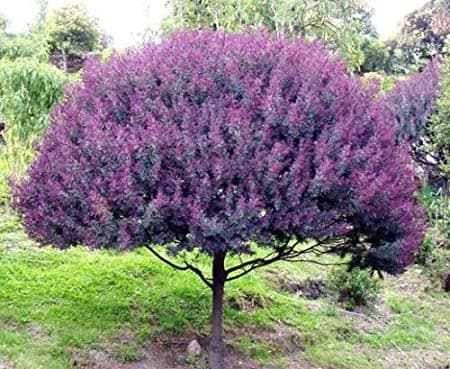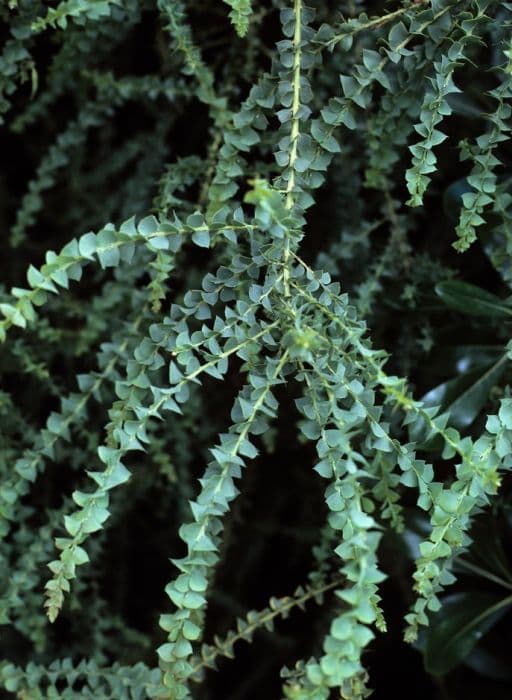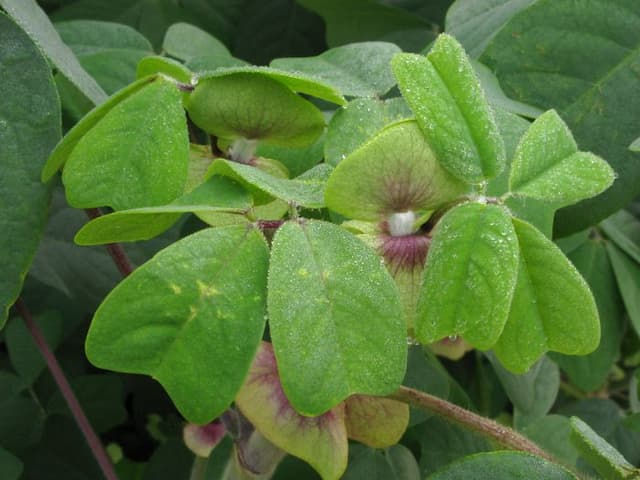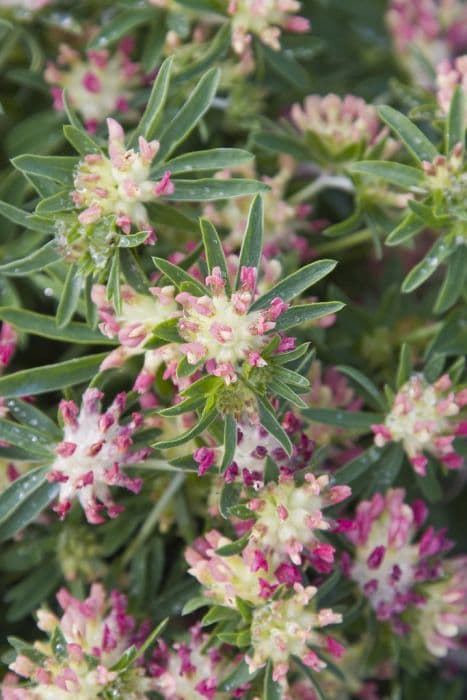Spring Vetchling Lathyrus vernus 'Little Elf'

ABOUT
Lathyrus vernus 'Little Elf', commonly known as spring vetchling, is a flowering perennial plant that adds a splash of color to the early spring garden. Emerging from the ground, the plant's foliage consists of delicate, paired leaflets that are a fresh, bright green. Each leaflet is slender, with a smooth edge, and are typically oblong in shape with a slightly pointed tip. As the plant matures in the spring season, it produces a profusion of flowers. These blooms are small and pea-like, with a charming bicolor effect: the petals display a delightful combination of purple and blue shades, sometimes accented with hints of pink or reddish-purple. The flowers are arranged in dense clusters, creating a striking display against the backdrop of the lush foliage. The contrast between the vibrant flowers and the greenery is quite striking, and this plant is often used in garden borders or as part of a woodland garden where it adds a touch of early season charm. After flowering, it produces pods that resemble those of other plants in the pea family. Overall, the spring vetchling 'Little Elf' is a plant that captures the essence of spring with its vivid blooms, providing a bridge between the end of winter and the onset of the full flush of the growing season. Its appearance holds an old-world elegance that can complement both formal and informal garden settings.
About this plant
 Names
NamesFamily
Fabaceae
Synonyms
Spring Vetchling, Spring Peavine, Eternal Pea, Dwarf Everlasting Pea
Common names
Lathyrus vernus 'Little Elf'.
 Toxicity
ToxicityTo humans
Spring vetch 'Little Elf' contains a neurotoxic amino acid known as ODAP or β-N-oxalyl-L-α,β-diaminopropionic acid, which can cause a neurological condition called lathyrism if ingested in large quantities over time. Lathyrism is characterized by muscle weakness and paralysis, which primarily affects the lower limbs, and can result in a crippling effect. Acute symptoms from ingestion are not commonly reported, but due to the potential for chronic toxicity, it is advisable to avoid consuming any part of this plant.
To pets
Spring vetch 'Little Elf' could be toxic to pets if ingested. The presence of ODAP can lead to the development of lathyrism in animals as well, which would manifest as neurological symptoms such as weakness and paralysis, particularly in the hind legs. This condition could potentially have long-term effects, and therefore, it is important to prevent pets from eating this plant.
 Characteristics
CharacteristicsLife cycle
Perennials
Foliage type
Deciduous
Color of leaves
Green
Flower color
Mixed
Height
1 foot 2 inches (35 cm)
Spread
1 foot (30 cm)
Plant type
Herb
Hardiness zones
5
Native area
Europe
Benefits
 General Benefits
General Benefits- Early Spring Blooms: Adds vibrant color early in the season when few other plants are flowering.
- Drought Tolerance: Once established, it is fairly resistant to short periods of drought, reducing the need for frequent watering.
- Pest Resistance: Lathyrus vernus 'Little Elf' is generally not prone to serious pest or disease problems.
- Attracts Pollinators: Flowers attract beneficial insects like bees and butterflies, supporting local ecosystems.
- Compact Growth: Suitable for small gardens or borders without overwhelming the space.
- Deer Resistance: Less appealing to deer, which helps prevent damage to the plant in areas where deer are a problem.
- Low Maintenance: Requires minimal care once established, making it ideal for busy gardeners.
- Mixed Planting: Works well in mixed beds, woodland gardens, or as underplanting for larger shrubs.
- Seasonal Interest: Provides spring interest with its flowers and adds texture to the garden with its foliage.
- Non-Invasive: Unlike some members of the Lathyrus genus, this variety does not aggressively spread, making it a good garden citizen.
 Medical Properties
Medical PropertiesThis plant is not used for medical purposes.
 Air-purifying Qualities
Air-purifying QualitiesThis plant is not specifically known for air purifying qualities.
 Other Uses
Other Uses- As a natural dye: The flowers of Spring Vetchling may be used to produce a gentle, earth-toned dye for fabrics, particularly useful in traditional crafts and textile art.
- Educational tool: Spring Vetchling can be used in botanical studies to educate students about early spring bloomers and plant life cycles in temperate climates.
- Photography subject: Due to its early spring flowers, Spring Vetchling offers photographers a subject for practicing macro and nature photography techniques.
- Garden border design: Its compact growth habit makes Spring Vetchling suitable for designing the forefront of mixed borders in landscaped gardens.
- Support for low-growing perennials: The plant can provide support for other low-growing perennials that might otherwise flop over without support.
- Seasonal interest: Spring Vetchling can be used by gardeners to provide an early splash of color before the main blooming season starts.
- Fairy gardens: Its diminutive size and charming flowers make Spring Vetchling an ideal plant for creating whimsical fairy gardens.
- Seed crafts: The seeds, once dried, can be used in craft projects or as an educational resource to show children the life cycle of plants.
- Culinary decoration: Edible flowers of Spring Vetchling can sometimes be used to decorate salads and desserts, provided they are free of pesticides and not consumed in large quantities.
- Potpourri ingredient: Dried flowers of Spring Vetchling can be included in potpourri mixes to add a subtle fragrance and a touch of natural beauty to a room.
Interesting Facts
 Feng Shui
Feng ShuiThe Spring Vetch is not used in Feng Shui practice.
 Zodiac Sign Compitability
Zodiac Sign CompitabilityThe Spring Vetch is not used in astrology practice.
 Plant Symbolism
Plant Symbolism- Renewal and Rebirth: As a herald of spring, Spring Vetchling symbolism is often connected with the renewal and rejuvenation that comes with the change of seasons.
- Beginning and Potential: The early blossom of the Spring Vetchling can represent the start of new ventures and the potential for growth.
- Youth and Vitality: The fresh appearance and the early blooming of Lathyrus vernus 'Little Elf' signify youth and the vigorous energy that accompanies it.
- Longing and Desire: In the language of flowers, vetches can sometimes symbolize a longing or desire for something or someone, which may extend to the Spring Vetchling variant.
 Water
WaterThe Spring Vetchling 'Little Elf' prefers consistently moist soil, so it's important to water it whenever the top inch of soil feels dry to the touch. Generally, this means watering approximately once a week, but this can vary depending on environmental conditions. Use about 1 gallon of water per plant each time you water, ensuring that you water deeply to encourage root growth. During the growing season in spring and summer, check the soil moisture more frequently and water as needed. Reduce watering in the fall and particularly in winter when the plant is dormant.
 Light
LightSpring Vetchling 'Little Elf' thrives in partial shade to full sun. The ideal spot would provide morning sun and afternoon shade, or dappled sunlight throughout the day. Avoid placing it in deep shade or in areas with intense, hot afternoon sun as both extremes can be detrimental to the plant's health.
 Temperature
TemperatureFor Spring Vetchling 'Little Elf', the ideal temperature range is between 50 and 70 degrees Fahrenheit. It can survive minimum temperatures of around 20 degrees Fahrenheit, making it resilient to frost and suitable for cooler climates. However, during periods of extreme heat, above 80 degrees Fahrenheit, it's important to provide some shade and ensure adequate moisture to prevent stress.
 Pruning
PruningPruning Spring Vetchling 'Little Elf' is typically done to remove spent flowers and to maintain plant shape. Deadheading after blooming encourages a tidier appearance and can promote a second flush of flowers. Pruning can be done in late winter or early spring, before the onset of new growth, to remove any dead or damaged stems.
 Cleaning
CleaningAs needed
 Soil
SoilSpring vetch 'Little Elf' thrives in well-draining soil that is rich in organic matter, with a soil pH of 6.0 to 7.5. A good soil mix for this plant could include equal parts of garden soil, compost, and leaf mold or peat, with a handful of perlite for improved drainage.
 Repotting
RepottingSpring vetch 'Little Elf' does not require frequent repotting and can be repotted every 2-3 years or when it outgrows its current container.
 Humidity & Misting
Humidity & MistingSpring vetch 'Little Elf' prefers moderate humidity but is adaptable to average household levels; it does not have specific high humidity requirements.
 Suitable locations
Suitable locationsIndoor
Place in bright indirect light and water regularly.
Outdoor
Plant in partial shade with well-draining soil.
Hardiness zone
4-8 USDA
 Life cycle
Life cycleLathyrus vernus 'Little Elf', commonly known as Spring Vetchling, begins its life cycle as a seed, often requiring a period of cold stratification to break dormancy. Upon warming temperatures in spring, the seed germinates and produces a small seedling, which develops a root system and foliage. As the plant matures, it grows into a bushy perennial with compound leaves, reaching up to 30 cm in height. Throughout late spring, it blooms with clusters of purple, pink, or white flowers, which are then pollinated, primarily by insects. Following pollination, the plant produces small pods containing the seeds, which mature by late summer and are eventually released to begin a new cycle. During winter, the aerial parts of the Spring Vetchling die back, while the root system remains dormant underground until the next spring.
 Propogation
PropogationPropogation time
Spring to Early Summer
Lathyrus vernus 'Little Elf', commonly known as Spring Vetchling, can be propagated by seed, which is the most popular method for this species. To propagate by seed, one should first collect the seeds when the pods have dried on the plant, usually in late summer. Once collected, the seeds often benefit from being nicked with a file or soaked in warm water for several hours to overnight to soften the seed coat, which enhances germination rates. Then, sow them directly into well-draining soil in a sunny to partially shaded location, planting them about a quarter of an inch deep (about 6 millimeters). It's important to keep the soil consistently moist until germination occurs, which should happen in the spring if seeds are planted in the fall, due to their need for a cold stratification period.









